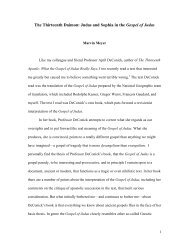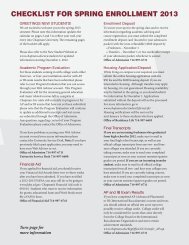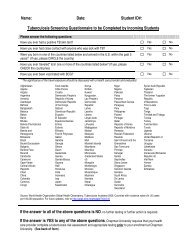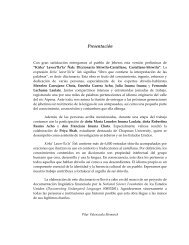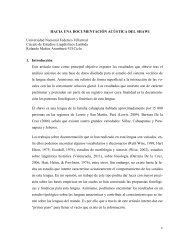“Surplus Humanity” and the Margins of Legality - Chapman University
“Surplus Humanity” and the Margins of Legality - Chapman University
“Surplus Humanity” and the Margins of Legality - Chapman University
Create successful ePaper yourself
Turn your PDF publications into a flip-book with our unique Google optimized e-Paper software.
Do Not Delete 12/12/2010 7:34 PM<br />
18 <strong>Chapman</strong> Law Review [Vol. 14:1<br />
―natural rate‖ <strong>of</strong> unemployment, <strong>and</strong> its <strong>of</strong>fspring—<strong>the</strong> nonaccelerating<br />
inflation rate <strong>of</strong> unemployment,‖ 116 <strong>and</strong> <strong>the</strong> ―labor<br />
force reserve.‖ 117 The reserve army <strong>of</strong> labor helps to contain<br />
significant wage increases <strong>and</strong> corresponding decline <strong>of</strong> pr<strong>of</strong>its. 118<br />
This dovetails with disciplinary uses <strong>of</strong> <strong>the</strong> poor <strong>and</strong> <strong>the</strong><br />
underclass in <strong>the</strong> market system. 119 Formation <strong>of</strong> <strong>the</strong> reserve<br />
army is <strong>of</strong>ten augmented by regional inequalities, racial divides<br />
<strong>and</strong> rural-urban migration. 120 Economists <strong>of</strong> all stripes recognize<br />
that <strong>the</strong> question <strong>of</strong> employment is not simply a matter <strong>of</strong> a ―free‖<br />
labor market, <strong>and</strong> that public policy plays a critical role in<br />
calibrating <strong>and</strong> managing unemployment. 121 Fiscal <strong>and</strong><br />
workers utilize <strong>the</strong>ir increased bargaining power to dem<strong>and</strong> raises in wages <strong>and</strong><br />
distribution <strong>of</strong> income in <strong>the</strong>ir favor. Pr<strong>of</strong>its are put under pressure. This leads to<br />
reduction in investment, a fall in employment, <strong>and</strong> a replenishment <strong>of</strong> <strong>the</strong> reserve army <strong>of</strong><br />
<strong>the</strong> unemployed. See Robert Pollin, The ―Reserve Army <strong>of</strong> Labor‖ <strong>and</strong> <strong>the</strong> ―Natural Rate <strong>of</strong><br />
Unemployment‖: Can Marx, Kalecki, Friedman, <strong>and</strong> Wall Street All Be Wrong?, 30 REV.<br />
OF RADICAL POL. ECON. 1, 4 (1998); Fred Magd<strong>of</strong>f & Harry Magd<strong>of</strong>f, Disposable Workers:<br />
Today‘s Reserve Army <strong>of</strong> Labor, 55 MONTHLY REV. 18, 21 (2004).<br />
116 See WENDY CARLIN & DAVID SOSKICE, MACROECONOMICS AND THE WAGE BARGAIN:<br />
A MODERN APPROACH TO EMPLOYMENT, INFLATION AND THE EXCHANGE RATE 5 (1990);<br />
THE NATURAL RATE OF UNEMPLOYMENT: REFLECTIONS ON 25 YEARS OF THE HYPOTHESIS<br />
(Rod Cross ed., 1995).<br />
117 The Labor Reserve Force is ―an estimate <strong>of</strong> <strong>the</strong> deviation <strong>of</strong> <strong>the</strong> actual labor force<br />
from <strong>the</strong> labor force that would be observed if <strong>the</strong> economy was continuously at full<br />
employment.‖ Wayne Vroman, The Labor Force Reserve: A Re-estimate, 9 INDUSTRIAL<br />
RELATIONS: J. ECON. & SOC‘Y 379, 379 (2008).<br />
118 David M. Gordon, Six-Percent Unemployment Ain‘t Natural: Demystifying <strong>the</strong> Idea<br />
<strong>of</strong> a Rising ―Natural Rate <strong>of</strong> Unemployment,‖ 54 SOC. RES. 223, 233–34 (1987); David M.<br />
Gordon, The Un-Natural Rate <strong>of</strong> Unemployment: An Econometric Critique <strong>of</strong> <strong>the</strong> NAIRU<br />
Hypo<strong>the</strong>sis, 78 AM. ECON. REV. 117, 122 (1988).<br />
119 See Herbert J. Gans, Positive Functions <strong>of</strong> <strong>the</strong> Undeserving Poor: Uses <strong>of</strong> <strong>the</strong><br />
Underclass in America, 22 POL. & SOC‘Y. 269, 272–73 (1994); Miles S. Kimball, Labor-<br />
Market Dynamics When Unemployment is a Worker Discipline Device, 84 AM. ECON. REV.<br />
1045, 1049 (1994).<br />
120 See Doreen Massey, Regionalism: Some Current Issues, 6 CAP. & CLASS 106, 114<br />
(1978); Richard Peet, Inequality <strong>and</strong> Poverty: A Marxist-Geographic Theory, 65 ANNALS<br />
ASS‘N. AM. GEOGRAPHERS 564, 567 (1975); Richard A. Walker, Two Sources <strong>of</strong> Uneven<br />
Development Under Advanced Capitalism: Spatial Differentiation <strong>and</strong> Capital Mobility,<br />
10 REV RADICAL POL. ECON. 28, 31 (1978). For mainstream <strong>the</strong>ories <strong>of</strong> rural-urban<br />
migration, see MICHAEL P. TODARO & STEPHEN C. SMITH, ECONOMIC DEVELOPMENT 335–<br />
37 (2006).<br />
121 See KEYNES, supra note 108; Palley, From Keynesianism to Neoliberalism, supra<br />
note 108. Michal Kalecki was <strong>the</strong> first to clearly state, in an appropriately titled chapter,<br />
―Political Aspects <strong>of</strong> Full Employment,‖ that while a capitalist economy can be sustained<br />
at full employment, this is <strong>the</strong> case only if challenges to capitalists‘ social <strong>and</strong> political<br />
hegemony can be contained by means <strong>of</strong> public policy. MICHAL KALECKI, SELECTED<br />
ESSAYS ON THE DYNAMICS OF THE CAPITALIST ECONOMY 138–45 (1971). The ―challenge‖<br />
was to devise a ―solution,‖ even if a fascist one, to capitalism‘s unemployment problem<br />
whereby workers would have jobs, but <strong>the</strong>y would not be permitted to exercise <strong>the</strong><br />
political <strong>and</strong> economic power that would o<strong>the</strong>rwise accrue to <strong>the</strong>m in a full-employment<br />
economy. Pollin, supra note 115, at 5. Even Milton Friedman, <strong>the</strong> veritable advocate <strong>of</strong><br />
<strong>the</strong> ―free market,‖ admitted that:<br />
[B]y using <strong>the</strong> term ―natural‖ rate <strong>of</strong> unemployment, I do not mean to suggest<br />
that it is immutable <strong>and</strong> unchangeable. On <strong>the</strong> contrary, many <strong>of</strong> <strong>the</strong> market<br />
characteristics that determine its level are man-made <strong>and</strong> policy-made. In <strong>the</strong>




